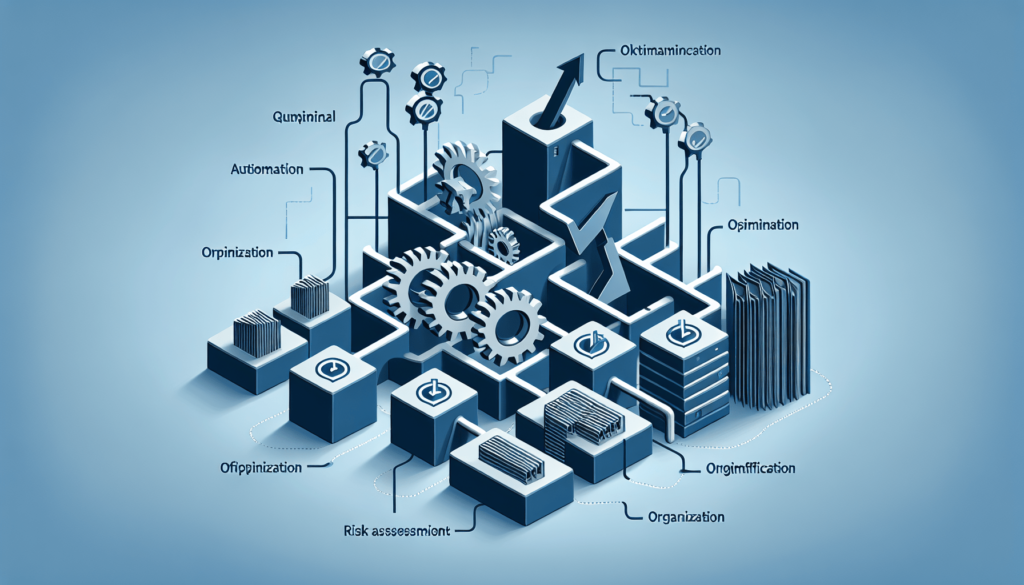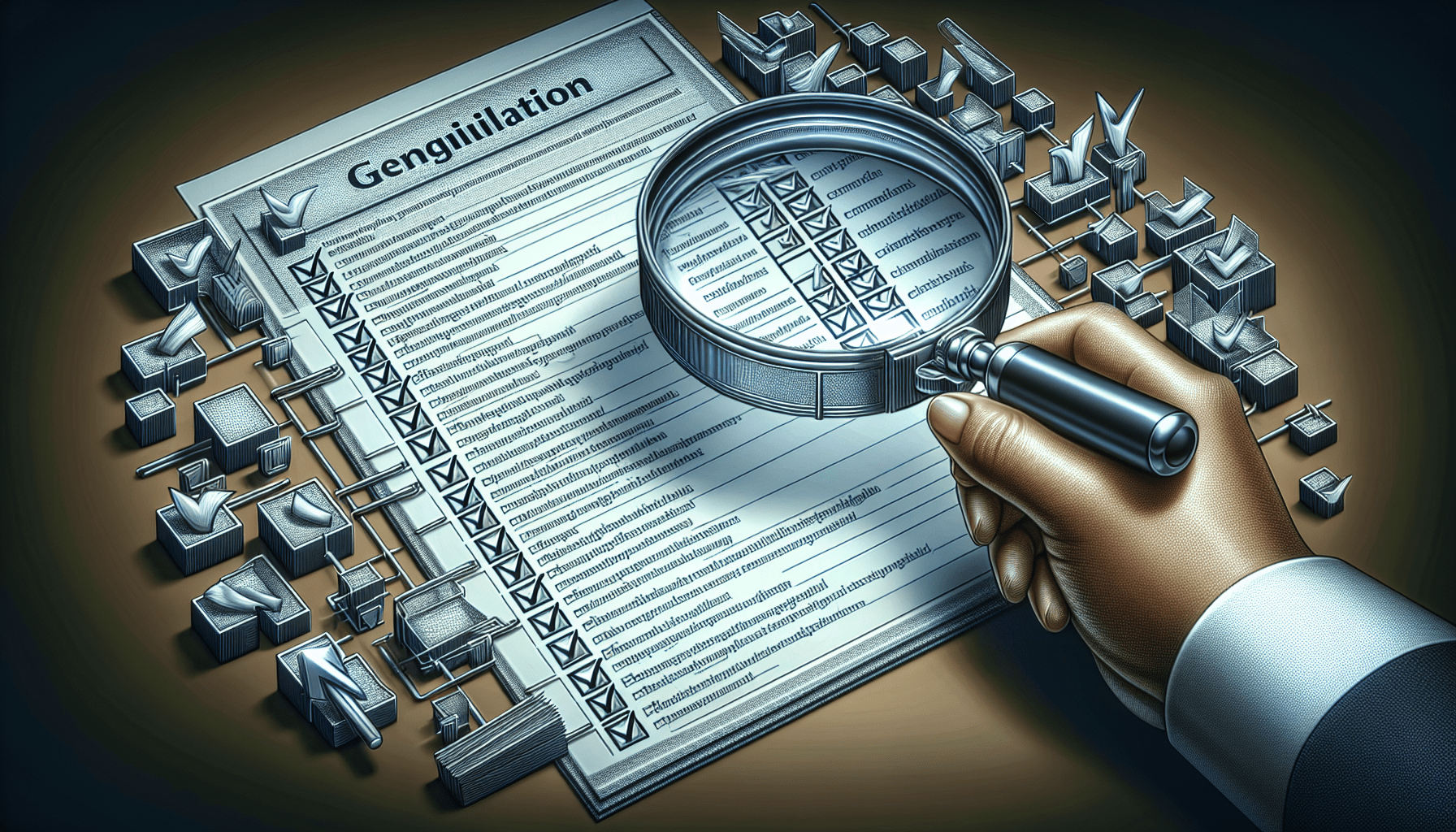In today’s rapidly evolving business landscape, ensuring compliance with industry regulations and maintaining strict adherence to internal policies is paramount. However, the compliance audit process is often seen as an arduous and time-consuming task that can disrupt normal operations. To overcome this challenge, it is crucial to implement effective strategies to streamline the compliance audit process. This article explores the top ways to optimize this process, enabling organizations to efficiently meet compliance requirements while minimizing disruptions to daily operations.

Automating data collection
Implementing automated data collection tools
Automating data collection is an essential component of streamlining the compliance audit process. By implementing automated data collection tools, you can simplify the process of gathering and organizing data, reducing the risk of errors and inefficiencies. These tools can automatically extract data from various sources, such as databases, spreadsheets, and even emails. By eliminating manual data entry tasks, you not only save time but also ensure the accuracy and reliability of the collected data.
Utilizing software for data extraction
Utilizing software for data extraction further enhances the efficiency of the compliance audit process. With the advancements in technology, there are now powerful software solutions available that can extract data from a wide range of formats, including PDF files, scanned documents, and images. This software utilizes optical character recognition (OCR) technology to convert unstructured data into structured data, making it easier to analyze and incorporate into your compliance audit procedures. By leveraging these tools, you can significantly reduce the time and effort required for data extraction, allowing your team to focus on more value-added tasks.
Using artificial intelligence for data analysis
Another way to streamline the compliance audit process is by utilizing artificial intelligence (AI) for data analysis. AI technologies can analyze large volumes of data in a fraction of the time it would take for a human auditor. These AI tools can identify patterns, anomalies, and trends within the data, providing valuable insights that can be used to identify potential compliance issues. By integrating AI into your data analysis processes, you can not only enhance the accuracy and effectiveness of your audits but also free up valuable resources that can be allocated to other critical areas of your compliance program.
Standardizing processes
Developing a standardized checklist
Developing a standardized checklist is a crucial step in standardizing and streamlining the compliance audit process. By creating a comprehensive checklist that covers all relevant compliance requirements, you ensure that all necessary tasks and procedures are consistently followed across all audits. This checklist acts as a guide for auditors, ensuring that they do not miss any critical steps and enabling them to conduct audits efficiently and effectively. By standardizing the checklist, you can achieve consistency in auditing practices, making it easier to identify and address compliance gaps.
Creating templates for documentation
Creating templates for documentation is another way to streamline the compliance audit process. Templates provide a standardized format for capturing audit findings, observations, and recommendations. By using pre-designed templates, auditors can easily document their findings and ensure that all relevant information is captured consistently. Templates can also include prompts and guidelines to ensure completeness and accuracy. By leveraging templates, you reduce the time and effort required for documentation, allowing auditors to focus on analyzing and addressing compliance issues.
Establishing uniform procedures across departments
To further streamline the compliance audit process, it is essential to establish uniform procedures across departments. By standardizing procedures, you ensure that all teams follow the same processes when conducting audits, eliminating inconsistencies and inefficiencies. This includes establishing guidelines for data collection, analysis, reporting, and corrective action implementation. By aligning procedures across departments, you facilitate collaboration and enhance the overall effectiveness of your compliance audit program. Regular communication and training sessions can help ensure that all employees understand and adhere to the standardized procedures.
Implementing workflow management
Utilizing workflow management software
Implementing workflow management software can significantly improve the efficiency and effectiveness of the compliance audit process. This software allows you to automate and monitor the progress of tasks throughout the audit lifecycle. You can create customized workflows that define the sequence of tasks, assign responsibilities, and set deadlines. Workflow management software provides transparency into the status of each task, allowing you to track progress, identify bottlenecks, and ensure timely completion of audits. By automating and centralizing task management, you can streamline the entire audit process, reducing the risk of delays and improving accountability.
Assigning tasks and deadlines
Assigning tasks and deadlines is a crucial aspect of streamlining the compliance audit process. By clearly defining the responsibilities and timelines for each audit task, you ensure that all necessary activities are completed within the desired timeframe. This requires careful planning and coordination between auditors, managers, and other stakeholders. By assigning tasks and deadlines, you promote accountability and create a sense of urgency, ensuring that audits progress smoothly and are completed in a timely manner.
Monitoring progress and completion
Monitoring the progress and completion of audit tasks is essential for streamlining the compliance audit process. It allows you to track the status of each task, identify potential bottlenecks, and take corrective action when necessary. Workflow management software can provide real-time visibility into task statuses, allowing you to monitor progress at a glance. Regular status updates, meetings, and reporting can also help ensure that audits are on track and that any issues or delays are promptly addressed. By closely monitoring progress and completion, you can proactively manage the audit process, minimizing risks and ensuring timely completion.
Training and education
Providing comprehensive compliance training
One of the key elements of streamlining the compliance audit process is providing comprehensive compliance training to auditors and relevant stakeholders. By ensuring that auditors have a deep understanding of the applicable laws, regulations, and internal policies, you empower them to conduct audits effectively and efficiently. Training should cover topics such as the audit methodology, data collection and analysis techniques, documentation practices, and reporting requirements. By investing in comprehensive compliance training, you enable auditors to perform their roles with confidence and competence, reducing the risk of errors and omissions.
Offering ongoing education and updates
In addition to initial training, offering ongoing education and updates is crucial to maintaining the effectiveness and efficiency of the compliance audit process. Compliance requirements and industry best practices are constantly evolving, and it is essential to keep auditors informed and up to date. This can be achieved through regular training sessions, webinars, newsletters, and other communication channels. Ongoing education ensures that auditors are aware of any changes in regulations or internal policies, allowing them to adapt their audit approaches accordingly. By providing ongoing education and updates, you promote continuous learning and improvement within your compliance audit program.
Empowering employees with knowledge and resources
Empowering employees with knowledge and resources is another important aspect of streamlining the compliance audit process. By providing auditors with access to comprehensive resources, such as compliance manuals, templates, and guidelines, you enable them to perform their roles more effectively. This includes ensuring that auditors have access to the latest versions of relevant policies, procedures, and regulations. By empowering employees with knowledge and resources, you enable them to make informed decisions, reduce the risk of errors, and contribute to the overall efficiency of the compliance audit process.

Improving communication
Establishing clear lines of communication
Establishing clear lines of communication is crucial for streamlining the compliance audit process. Effective communication ensures that all stakeholders are informed and engaged throughout the audit lifecycle. This includes auditors, managers, compliance officers, and other relevant individuals. Clear lines of communication help in clarifying expectations, sharing updates, and addressing any issues or concerns. This can be achieved through various channels, such as regular meetings, email updates, and dedicated communication platforms. By establishing clear lines of communication, you facilitate collaboration, reduce misunderstandings, and ensure that audits progress smoothly.
Promoting open dialogue and feedback
Promoting open dialogue and feedback is another way to enhance communication and streamline the compliance audit process. By fostering an environment that encourages auditors to ask questions, seek clarifications, and provide feedback, you create opportunities for continuous improvement. Open dialogue helps in addressing any concerns or challenges faced by auditors, enabling them to perform their roles more effectively and efficiently. Feedback loops can be established through regular meetings, surveys, and anonymous reporting mechanisms. By promoting open dialogue and feedback, you create a culture of transparency and continuous learning within your compliance audit program.
Utilizing collaborative tools and platforms
Utilizing collaborative tools and platforms can significantly improve communication and collaboration within the compliance audit process. These tools enable auditors to share documents, exchange information, and collaborate in real-time, regardless of their physical location. Collaborative platforms can also facilitate the assignment and tracking of tasks, ensuring that all stakeholders are aware of their responsibilities and deadlines. By leveraging collaborative tools and platforms, you enhance the efficiency of communication, reduce the risk of miscommunication, and enable auditors to work together seamlessly.
Utilizing data analytics
Leveraging data analytics tools
Utilizing data analytics tools is a game-changer when it comes to streamlining the compliance audit process. Data analytics tools enable auditors to analyze large volumes of data quickly and accurately, identifying trends, patterns, and anomalies. These tools can provide valuable insights that can be used to identify potential compliance issues, prioritize audits, and focus resources on high-risk areas. By leveraging data analytics tools, you can enhance the effectiveness and efficiency of your audits, enabling auditors to make data-driven decisions and allocate resources more strategically.
Identifying trends and patterns
One of the key benefits of utilizing data analytics in the compliance audit process is the ability to identify trends and patterns. Data analytics tools can analyze historical data to identify recurring patterns or anomalies that may indicate potential compliance issues. By identifying trends and patterns, auditors can target their efforts on areas that are most likely to have compliance issues, reducing the need for widespread audits and minimizing resource requirements. This targeted approach allows for more efficient use of resources and enables auditors to address compliance gaps more effectively.
Making data-driven decisions
Data-driven decision-making is a fundamental principle in streamlining the compliance audit process. By leveraging data analytics tools, auditors can make informed decisions based on objective data rather than subjective opinions or assumptions. This ensures that audits are focused on areas that are most likely to have compliance issues, maximizing the efficiency and effectiveness of each audit. Data-driven decisions also provide a solid foundation for prioritizing corrective actions and allocating resources. By embracing data-driven decision-making, you create a more efficient and reliable compliance audit process.
Enhancing document management
Implementing a centralized document management system
Enhancing document management is essential for streamlining the compliance audit process. By implementing a centralized document management system, you ensure that all relevant documents and records are organized, easily accessible, and up to date. A centralized system eliminates the need for manual document handling and minimizes the risk of lost or outdated information. It enables auditors to quickly locate and retrieve the necessary documents during audits, saving time and effort. With a centralized document management system, you can also enforce version control, ensuring that auditors are always working with the latest versions of documents.
Ensuring proper categorization and organization
Proper categorization and organization of documents are crucial for efficient compliance audits. By establishing a logical and consistent filing system, you facilitate easy retrieval of documents during audits. This includes using standardized naming conventions, folder structures, and metadata tags. Proper categorization and organization enable auditors to quickly locate and review the relevant documents, ensuring that the audit process progresses smoothly. By promoting proper categorization and organization, you eliminate the frustration and delays caused by searching for and sifting through unorganized document repositories.
Implementing version control and access restrictions
Implementing version control and access restrictions is another important aspect of enhancing document management in the compliance audit process. Version control ensures that auditors are always working with the latest versions of documents, minimizing the risk of outdated or conflicting information. This can be achieved through document management software that tracks and manages document versions. Access restrictions, on the other hand, ensure that only authorized individuals can view or edit sensitive documents. By implementing version control and access restrictions, you enhance the integrity and security of your document management processes, promoting efficient and compliant audits.
Conducting regular internal audits
Performing frequent internal audits
Conducting regular internal audits is a critical component of streamlining the compliance audit process. Internal audits help identify and address compliance gaps before external audits or regulatory inspections occur. By performing frequent internal audits, you can proactively identify areas for improvement, address non-compliance issues, and prevent potential penalties or reputational damage. The frequency of internal audits should be determined based on the nature and complexity of your business operations, industry regulations, and risk assessments. Regular internal audits ensure that your compliance program remains up to date, efficient, and effective.
Identifying and addressing compliance gaps
The primary purpose of conducting regular internal audits is to identify and address compliance gaps. Internal audits provide an opportunity to assess the effectiveness of your compliance program, controls, and procedures. By systematically reviewing and analyzing your organization’s compliance processes, you can identify areas where improvements are needed. This may include gaps in policies, procedures, training, or controls. Identifying and addressing compliance gaps allows you to strengthen your compliance program and mitigate the risk of non-compliance. By proactively addressing compliance gaps, you ensure that your organization operates in accordance with applicable laws, regulations, and industry standards.
Implementing corrective actions
Internal audits serve as a catalyst for implementing corrective actions. Once compliance gaps are identified, it is essential to develop and implement corrective actions to address these gaps effectively. Corrective actions may include updating policies and procedures, enhancing employee training, modifying controls, or implementing new processes. It is crucial to prioritize corrective actions based on the severity of the non-compliance risk and allocate appropriate resources for their implementation. By promptly implementing corrective actions, you demonstrate your organization’s commitment to continuous improvement and ensure compliance with applicable requirements.
Engaging external experts
Hiring external compliance consultants
Engaging external compliance consultants can bring valuable expertise and perspectives to streamline the compliance audit process. Compliance consultants specialize in various areas of compliance, including regulatory requirements, industry standards, and best practices. By hiring external consultants, you gain access to their knowledge, experience, and insights, which can help optimize your compliance program and audit processes. Consultants can provide recommendations for improving controls, enhancing documentation, and streamlining procedures. They can also offer an independent assessment of your compliance program’s effectiveness, identifying any areas for improvement. By leveraging the expertise of external compliance consultants, you can enhance the efficiency and effectiveness of your compliance audit process.
Seeking third-party audits
Another way to streamline the compliance audit process is by seeking third-party audits. Third-party audits provide an independent assessment of your compliance program and controls. These audits are conducted by external auditors or certification bodies who have expertise in specific compliance standards or regulations. Third-party audits help validate the effectiveness and integrity of your compliance program, as well as identify any areas for improvement. By undergoing third-party audits, you demonstrate your commitment to compliance and build trust with stakeholders, including regulators, customers, and business partners. Third-party audits can also serve as a benchmark for your internal audits, enabling you to compare your performance against industry standards and best practices.
Utilizing expert advice and recommendations
Engaging external experts can also involve utilizing their advice and recommendations to streamline the compliance audit process. External experts, such as industry associations, professional organizations, or regulatory bodies, often publish guidance documents, best practices, and recommendations. By leveraging these resources, you can stay updated with the latest compliance requirements, industry trends, and audit methodologies. Expert advice can help you optimize your compliance audit processes, identify areas for improvement, and ensure that your audits align with industry-leading practices. By utilizing expert advice and recommendations, you enhance the overall efficiency and effectiveness of your compliance audit program.
Continuous improvement and adaptation
Being proactive in identifying areas for improvement
Continuous improvement and adaptation are essential to streamlining the compliance audit process. Being proactive in identifying areas for improvement involves regularly reviewing and evaluating your compliance program, processes, and audit methodologies. This includes conducting self-assessments, analyzing audit findings, and seeking feedback from auditors and stakeholders. By actively seeking opportunities for improvement, you can identify any gaps, inefficiencies, or challenges in your compliance audit process. Being proactive allows you to make timely adjustments, implement preventive measures, and continually enhance your compliance program’s effectiveness.
Evaluating and adjusting compliance processes
To streamline the compliance audit process, it is crucial to regularly evaluate and adjust your compliance processes. This involves assessing the effectiveness and efficiency of your existing processes, including data collection, data analysis, documentation, and reporting. By evaluating the strengths and weaknesses of your processes, you can identify opportunities for improvement and make necessary adjustments. This may include implementing new technologies, updating procedures, or reallocating resources. By continually evaluating and adjusting your compliance processes, you ensure that they remain aligned with your organization’s goals, industry best practices, and regulatory requirements.
Staying updated with regulatory changes
Staying updated with regulatory changes is vital for streamlining the compliance audit process. Regulations and industry standards frequently evolve, and it is essential to stay informed about any changes that may impact your compliance program. This includes monitoring regulatory websites, subscribing to industry publications, and participating in relevant conferences or webinars. Staying updated allows you to proactively address any changes in compliance requirements and adapt your audit processes accordingly. By staying ahead of regulatory changes, you ensure that your compliance audits remain relevant, effective, and compliant with the latest standards and regulations.
In conclusion, streamlining the compliance audit process requires a comprehensive approach that incorporates various strategies and tools. Automating data collection, standardizing processes, implementing workflow management, providing training and education, improving communication, utilizing data analytics, enhancing document management, conducting regular internal audits, engaging external experts, and embracing continuous improvement and adaptation are all key components of an efficient and effective compliance audit program. By implementing these strategies and leveraging the available tools and technologies, organizations can streamline their compliance audit processes, reduce risks, enhance compliance, and ultimately protect their reputation and bottom line.
Word count: 3197 words



